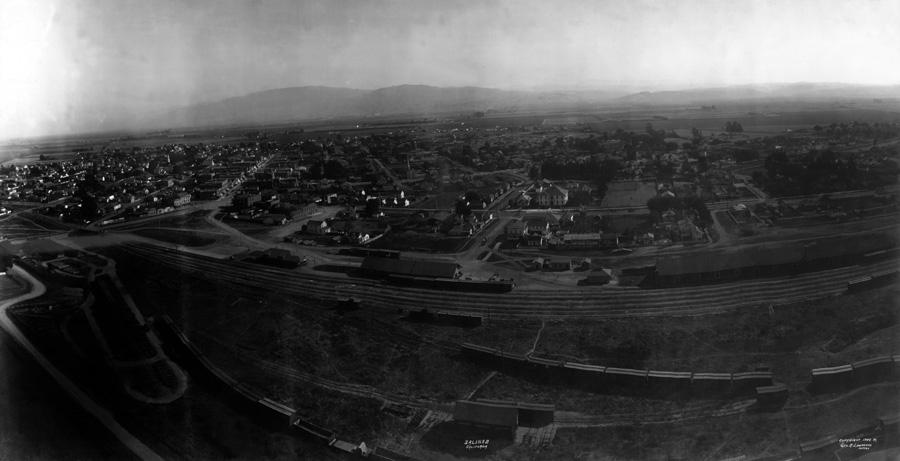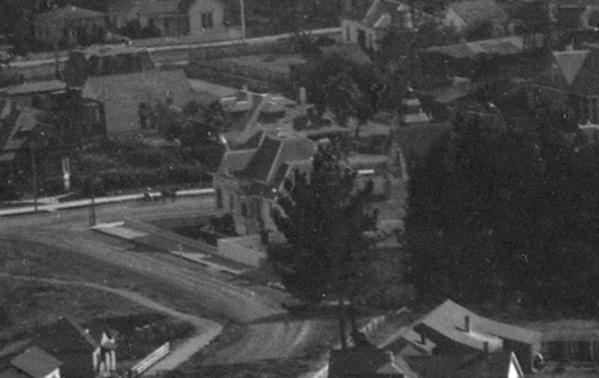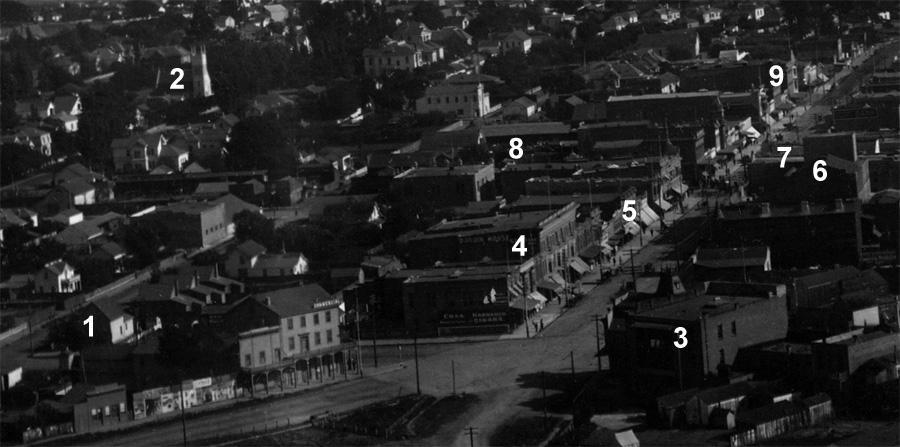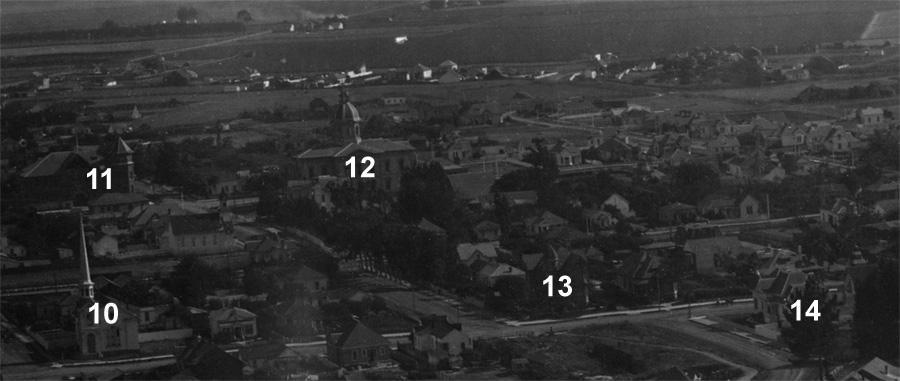Notes on George Lawrence's 1906 Panoramas
of Salinas, California
by Peter NurkseJanuary 2011
PDF version

You can view larger scans of this panorama here: Left half, Right half.
The Salinas picture has a large railroad yard in the foreground, taking up almost half the picture, perhaps because the railroad connections were a key asset of Salinas in 1906. Quite likely people in Salinas asked Lawrence to be sure he featured the railroad yards prominently, he probably would usually check with the locals before taking a panorama since he wanted customers for the pictures.
The picture was taken facing south, towards Mt. Toro, on the skyline to the left of center. The sun is setting, so the building facades facing west are more brightly illuminated than any other features in the picture. Although Lawrence’s most famous picture, the Ruins of San Francisco, was taken directly into the setting sun, normally he preferred to have the sun overhead in his panoramas, for a more uniform exposure.
Lawrence designed his kite aerial photography setup as a complete system, where different factors were adjusted to work together. He usually took pictures from a camera height of 800 to 1000 feet. His film exposure was calibrated to the camera height, and he also used a shield over the lens to give more exposure to the distant background, and less exposure to the foreground.
Judging by the size of the railroad cars in the foreground, this picture was probably taken from a much lower altitude, perhaps 400 feet. For whatever reason, it seems Lawrence took this picture in a hurry, at the end of the day, from a lower altitude than usual, under difficult conditions, and the overall picture doesn’t seem up to his usual standard.
But there is a remarkable building in this picture for us today, the Steinbeck house, where John Steinbeck grew up and lived until age seventeen, still there today at the corner of Stone St. and Central Ave. The house is close to the exact center of the picture, as if featured in the panorama:

This is a casual view from the back, partly obscured by a tree, not like the pictures of the Steinbeck house in Salinas today. Because this picture was taken before Steinbeck received the Nobel Prize, when he was just 4 ˝ years old, digging in dirt and playing with toys, when this house was simply another house in Salinas, nothing else.
There is a possible lesson there: nobody in Salinas in 1906 could have expected this small boy would become better known than the entire town. Any 4 ˝ year old child today could become more famous in a century than a city, destiny and genius at work.
Just because the Salinas picture has those technical problems with exposure, it may have more to say about the relationships between us and the past and the future, and it may be a more profound picture. The technical problems may simply encourage us to look more deeply at the picture, almost as if intended so.
"Images of America: Early Salinas", by Gary S. Breschini, Mona Gudgel, and Trudy Haversat, is a good illustrated guide to many of the buildings and places in the 1906 panorama. Page numbers following are references to the book.

1) Joseph V. Lacey Blacksmith Shop: at the southwest corner of Market and Monterey St. (p. 26). In 1907 Lacey already had built an automobile garage here (p. 39), but it’s not visible in this 1906 picture. Perhaps the garage was new in 1907.
2) United Presbyterian Church.
3) Salinas Hotel: on W. Market at Main (p. 15). Looking at the hotel from behind, the distinctive top story of the tower on the Main St. side is quite visible.
4) Bardin House Hotel: you can read the name on the side of the building in the full size copy of the panorama (p. 19). Later it was renamed the Hotel Franciscan (p. 38), and burned down in 1945.
5) Clark and McCollum Store: in the two story brick building, with Butler Photographers next door on the far side in the one story white wooden building (p. 20).
6) Salinas Opera House: marked by the tall square scenery tower (or "fly tower"), where scenery changes were stored above the stage (p. 16).
7) Abbott House: (p. 16) built on the site of the original Half Way House, the first structure of any kind in Salinas. The Half Way House was named because it was half way between Monterey and San Juan Bautista.
8) heaviest quake damage in 1906 was along Gabilan St., on both sides of Main St. (p. 72 - 73). On the left side of Main St. you can see a break in the rooflines on the far side of Gabilan St., where buildings collapsed. On the right side of Main St the Ford and Sanborn department store collapsed, although not visible here.
9) Hotel Jeffrey: two side windows, one above the other, are pointing up Main St. directly at the camera, in the two bay windows on the Alisal St. corner (p. 17). The hotel had a large modern annexe by the 1930’s (p. 39), although the original building with the bay windows was still there in 1937 (p. 41).

10) First Presbyterian Church.
11) Salinas High School, built 1900 (p. 91). Even though known as the "brick yard", because built extensively of brick, the building apparently survived the 1906 earthquake well. John Steinbeck graduated here in 1919, in one of the last classes, since it was replaced by the new high school in 1921 (p. 114).
12) County Courthouse, built about 1877 (p. 91). When the time came to replace this building in 1937, a new courthouse was built entirely surrounding it on all sides, and then the old courthouse was torn down, leaving an open courtyard in the middle of the new courthouse (p. 93).
13) Berges House, built about 1899 and torn down in 1964. The picture in the book (p. 67) shows the size and ornamentation of this house, which was almost directly across the street from the Steinbeck House.
14) Steinbeck House. Originally the J.J. Connor House, it was built in 1897 and sold to the Steinbecks in 1902 (p. 66). Probably early in 1902, since John Steinbeck was born here on Feb. 27, 1902